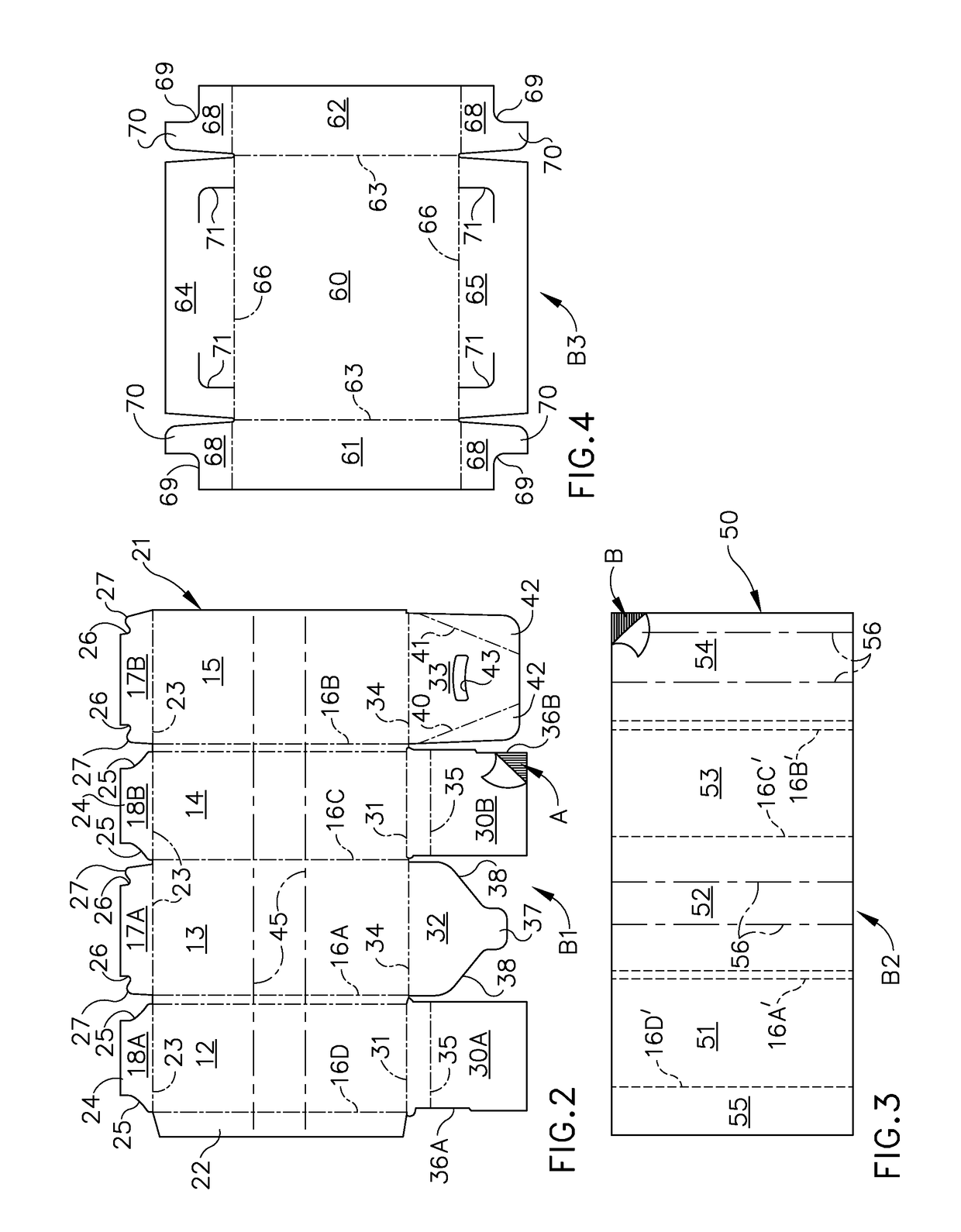Reinforced cross-laminated bulk container
a cross-laminated, bulk container technology, applied in the direction of containers, packaging, transportation and packaging, etc., can solve the problems of difficult fabrication and tab bendage, and achieve the effect of reducing the grad
- Summary
- Abstract
- Description
- Claims
- Application Information
AI Technical Summary
Benefits of technology
Problems solved by technology
Method used
Image
Examples
second embodiment
[0049]FIG. 7 is a top plan view of an alternative blank B4 for making the outer component of an alternative container 10′ according to the invention. The blank B4 comprises four sidewall panels 12′, 13′, 14′ and 15′ joined together along the respective scores 16A′, 16B′ and 16C′, with a glue flap 22′ foldably joined to one end edge of the blank B4 along the score 16D′ which effectively joins panel 12′ to panel 15′ when the container 10′ is constructed. The scores 16A′ and 16B′ are double scores as more fully described hereinafter and illustrated in applicant's prior U.S. Pat. No. 4,693,413, the disclosure of which is incorporated in full herein by reference. As described in that patent, the scores 16A′ and 16B′ extend along those corners joining sidewall panels that move through 180 degrees between the unfolded position of the blank B4 and the folded flat position of a container made from the blank.
[0050]In the second embodiment shown in FIG. 7, substantially identical bottom flaps ...
first embodiment
[0053]Similar to the first embodiment as shown in FIG. 2, a pair of reinforcing strands 45′ of Sesame Tape or other reinforcing strand known in the art extends across the blank B4 from one end edge to the other approximately midway between the top and bottom edges thereof. As indicated by the arrow “A” in FIG. 2, the corrugations of the outer component 21′ extend perpendicular to the top and bottom edges of the blank B4, and the reinforcing strands extend perpendicular to the corrugations.
[0054]FIG. 8 is a top plan view showing the inner liner 50 in FIG. 3 laminated to the outer component 21′ to form a laminated blank 57′ from which the container 10′ is erected according to the second embodiment of the invention. It will be noted that the liner 50 is shifted to the left as viewed in FIG. 8, with the glue flap 55′ on the liner projecting beyond the glue flap 22 on the outer component 21′, and the opposite end of the liner inset relative to the adjacent end of the outer component, def...
third embodiment
[0056]FIG. 10 is a top plan view showing the inner liner 50 in FIG. 3 laminated to the outer component 21″ preparatory to form a laminated blank 57″ from which the container 10″ is erected according to the invention. It will be noted that the liner 50 is shifted to the left as viewed in FIG. 10, with the glue flap 55″ on the liner projecting beyond the glue flap 22″ on the outer component 21″, and the opposite end of the liner inset relative to the adjacent end of the outer component, defining a space 58″ for attachment of the glue flap 55″. The Construction of the blank B5 including the inner liner 50 laminated thereto to form the container 10″ will be described hereinafter.
[0057]To set up a container 10′ and 10″ from its flattened condition to its expanded operative condition, it is opened into a tubular configuration and the partial top flaps are folded into their operative interlocked position as described previously herein. The container is then inverted so that it rests on its...
PUM
 Login to View More
Login to View More Abstract
Description
Claims
Application Information
 Login to View More
Login to View More - R&D
- Intellectual Property
- Life Sciences
- Materials
- Tech Scout
- Unparalleled Data Quality
- Higher Quality Content
- 60% Fewer Hallucinations
Browse by: Latest US Patents, China's latest patents, Technical Efficacy Thesaurus, Application Domain, Technology Topic, Popular Technical Reports.
© 2025 PatSnap. All rights reserved.Legal|Privacy policy|Modern Slavery Act Transparency Statement|Sitemap|About US| Contact US: help@patsnap.com



